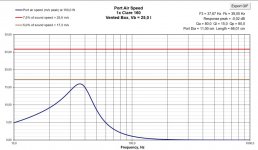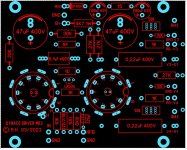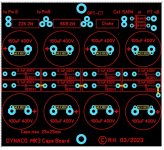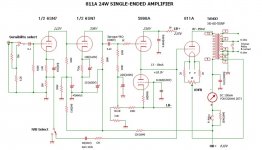For many years I was content to parallel TDA1387s to get lower noise. Its datasheet SNR - the maximum signal divided by the noise at digital zero - is 98dB typical, A-weighted. Since I'm not a fan of using weighting to goose the numbers, I tend to just subtract 3dB from A-weighted numbers to arrive at an approximate (unweighted) figure of 95dB. When comparing chips' specs, its important to filter out marketing fluff like the use of A-weighting.
Since doubling the number of chips doubles the current but the noise only rises by 3dB (because its uncorrelated between chips), doubling the chips improves the SNR by 3dB. 256 chips is 2^8 so should in theory get us an improvement of 24dB, or to 119dB SNR. Fine in theory, but the assumption that noise is uncorrelated won't hold if the source of that noise is the power rail since that's going to affect all chips equally. So attention needs to be paid to the cleanliness of supplies, or alternatively ensure that each DAC chip's supply is separate and hence not correlated with the others.
There are a few practical issues with 256 chips, not least of which is soldering that many chips down to boards. The current demand from the PSU isn't trivial either, around 1.4A. If the chips are packed too close, heating becomes an issue too since the array of chips is dissipating about 7W. Then there's the question of how to deal with a current output of +/-128mA. All these difficulties gradually pushed me in the direction of seeking out other DAC chips. I started at the cheapest multibits (based on Taobao pricing which often means recycled chips) and have begun to work my way upwards....
PCM56 has a DS typical output noise of 6uV. That's specified in micro-volts because it has an internal opamp to give it a voltage output of 2VRMS. Dividing the max output by the noise number takes us to 110dB. Already its equivalent in SNR to an array of 32 TDA1387s but the noise from the current output (which is what I'll use) is going to be lower because the opamp has to add some noise. How much noise is hard to estimate but we can put some bounds on it. Seeing as the opamp sees the 1200R Zout of the DAC to GND and its feedback R is about 3k, its noise gain is (1+3/1.2) = 3.5. So for output noise of 6uV, the noise RTI (referred to input) must be 6/3.5 = 1.7uV. If the opamp were equivalent to an NE5534, that has noise RTI of 0.6uV. (I'm excluding resistor noise here). Such a noise contribution is negligible compared to the DAC's own noise but if the opamp were significantly noisier than 5534 then its contribution would start to matter.
The next chip of interest on Taobao is PCM58. Its datasheet noise is unbelievably low, specified as -126dB, A-weighted. This figure merits some deconstruction as its far above all other R2R DACs I've looked at. Reading the small print its measured with an OP27 (pretty low noise) and a 10k feedback resistor. I wonder why they chose 10k as its not at all typical in an audio application. Perhaps its their way of gooseing the figures? Since the feedback R is 10k, the maximum output level must be 10V peak, or 7VRMS. Taking 123dB as the unweighted number, the output noise must be 5uV. The OP27 noise gain is (1+10k/1k2) = 9.3 so RTI noise must be 0.5uV, pretty impressive. OP27 has 0.4uV RTI noise. I don't think this claim holds up under examination since we've also not included resistor noise. Or perhaps I'm missing out something vital in my analysis. Anyway, even if the real figure is 6dB worse than claimed its still a good deal lower noise than PCM56.
There's something else very interesting about PCM58 which isn't a feature of many other R2R DACs, that's the presence of the 'BPO' pin. PCM63 also has this but its not shown in any other DS for BB DACs to my knowledge, not even PCM63's successors PCM1702 and PCM1704. What 'BPO' stands for is bipolar offset. It turns out the internal DAC architecture isn't bipolar, its single-ended. Meaning it only sources (or sinks) current, it doesn't do both. To make PCM58 output a bipolar current, it needs an additional current source combining with the DAC proper output, this current source is connected to pin BPO. Even AD1862's internal architecture drawing shows a resistor feeding the output from the Vref, making the output bipolar. ( I'm guessing here no DAC is truly bipolar, they're all unipolar and need an additional current source tweaking the output). On AD1862 there's no BPO pin, you cannot disconnect the offsetting resistor. On PCM58 (and PCM63) you can. I think the ability to disconnect BPO is a valuable tweak in the quest for ever lower noise.





























































































